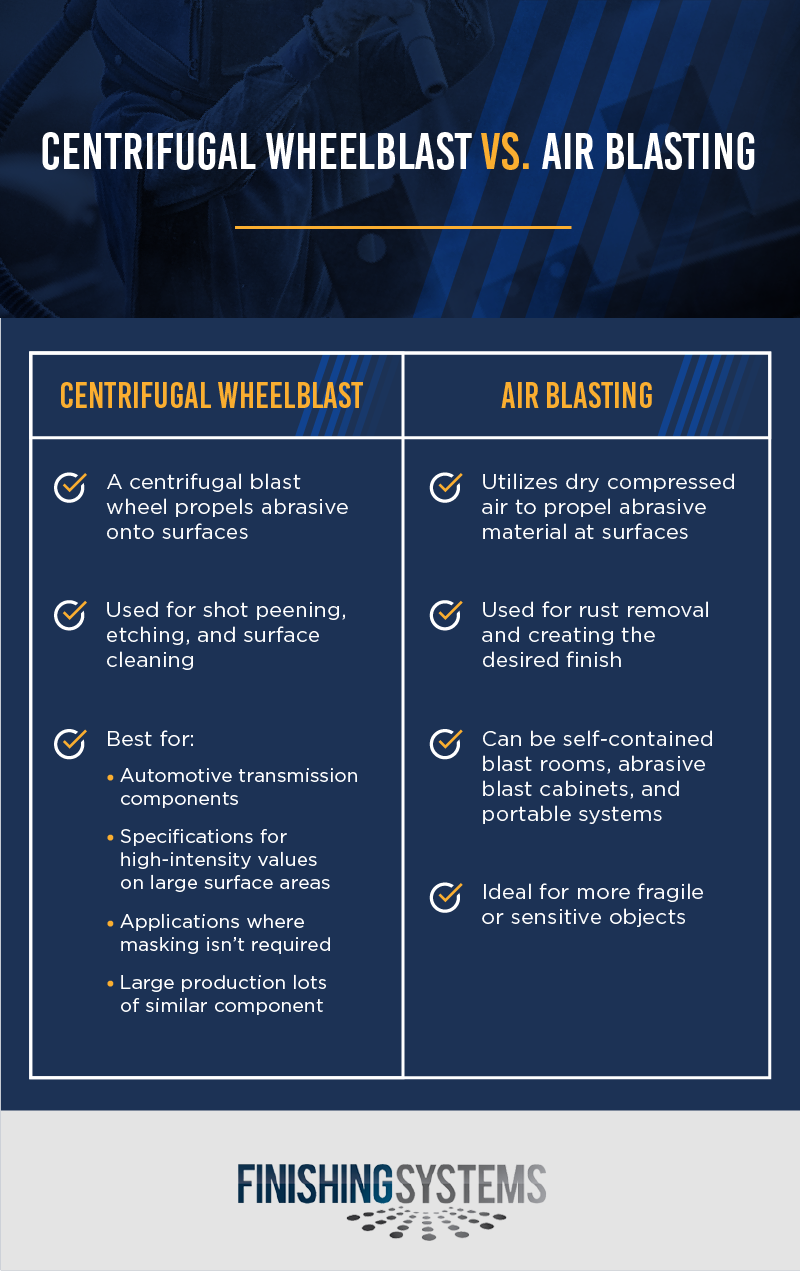Centrifugal Wheelblast vs. Air Blasting: Which Is Right for You?
Updated: October 17, 2023Which type of abrasive blasting operation is best suited for your application ? Both Wheel Blasting and Air Blasting propel abrasive media onto the surface of a metal component to descale, etch, peen, or clean your parts. Depending on the size, configuration, and quantity of your pieces can be a key factor in selecting the appropriate blasting operation to achieve your end results. Selecting the proper equipment, process cycle, and media insures that your parts receive the proper finish in the most cost-effective and efficient means of delivery.
With a variety of different blast materials and blast methods to choose from, selecting the right one can be a little daunting. If you’re trying to decide when to wheel blast and when to air blast, this guide will hopefully assist you in making the right decision.
What Is Wheel Blasting?
Wheelblast equipment uses a centrifugal blast wheel to propel abrasive onto the surface of your parts. Shot peening, etching, and surface cleaning are just a few reasons to use wheel blasting.
Compared with Wheelblast equipment, an Air Blast operation propels a fraction of the quantity of blast media onto the surface of the part. Centrifugal blast wheels are either direct driven or belt driven through a bearing system. Of course the speed of the blasting operation’s time cycle correlates directly with the speed and horsepower of the blast wheel. The wheel speed is adjustable in VFD (variable frequency drive) model machines.
Evaluating the criteria of your application helps make the proper decision when selecting between wheelblast or airblast equipment.
- Ideally suited for automotive transmission components like shafts or gears, leaf springs, axle beams and connecting rods and railway applications
- Processing specifications for high intensity values on large surface areas
- Applications where masking is not required and the entire surface is to be treated with abrasive
- Large production lots of similar component
Abrasive (usually a metallic shot or grit) is charged into the machine while your batch of parts are loaded into the chamber of the Wheelblast equipment. The machine’s blast wheel mechanism uses centrifugal force to blast parts with an even blast pattern on all surfaces of your parts. Typically you can place larger batches of a smaller component into the mechanism or fewer, larger objects. With short cycle times in the machine, your objects will be finished relatively quickly.
This process is best suited for metallic abrasives such as steel shot or grit, zinc or aluminum cut wire, stainless steel shot or grit.

What Is Air Blasting?
Air blast equipment utilizes compressed air to propel an abrasive material at the surface of your parts. An adequate supply of compressed air is essential for efficiency. you use compressed air through a nozzle to shoot blast materials against an object on a work surface. It’s also used in a variety of different applications, from rust removal to creating the desired finish.
Abrasive air blast systems can be self contained blast rooms, abrasive blast cabinets (direct pressure or suction type systems) and portable types of Air Blast equipment. Proper dust collection in the aforementioned equipment insures a clean and visibly clear working environment.
Choosing Which Is Best for You
When looking at wheel blasting vs. air blasting and deciding which one is best for you, it helps consider the unique advantages of both processes. This information can help you make the right decision on which type is best for your unique needs.
The main advantages of wheel blasting are its speed, efficiency and ability to blast larger objects. With air blasting, larger objects are more difficult to finish because it has a more concentrated blast area. Wheel blasting is also less expensive for those larger objects.
When you’re blasting more fragile or sensitive objects, a direct pressure type of air blasting cabinet can be the better option. It insures a closer control of the pressure of the blast stream Here again, you can vary the final finish by using the proper blast medium.
Work With Finishing Systems to Find Your Best Option
If you’re still unsure about which process is better for you or if you’re looking to install equipment for either process, choose Finishing Systems. With an excellent variety of blasting and finishing equipment and blast media available, you can find the perfect combination to achieve the right finish.
To learn more, please contact us today.
